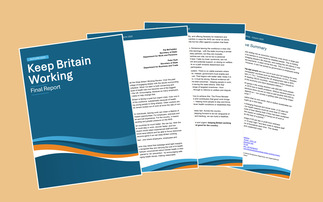Latest SME research from Legal & General indicates that everything is interdependent and won’t be realised without listening to employees, writes L&G's Colin Fitzgerald
It may seem counterintuitive to find that mitigating talent risk is a top CEO priority at the moment, when in theory employers will be able to take their pick from a market flooded with recently let-go-of employees. Surely this should be way down the CEO agenda? Well, not quite - in fact not at all.
Recent research shows that maintaining employee trust in order to help mitigate talent risk is a top CEO priority1 as organisations rethink and reinvent how they work in response to the Covid-19 pandemic. This is about maximising existing talent, as opposed to spending £30,000 per person each time someone is replaced. That excludes salary - it can take five to six months for people to simply become profitable.2 Business recovery now rests on trust and engagement.
Legal & General's latest SME research3 - reported exclusively in COVER - finds that there's a direct correlation between size of company and trust. Size matters. And small is best when it comes to the level of trust that employees have in their employer. So, as the economic crisis deepens and nine in 10 CEOs believe wellbeing initiatives are key to driving long-term changes to their business model4, what can larger SMEs learn from their micro peers? And how can the insurance industry help?
Nearly three quarters (74%) of workers in micro businesses trust their employer to look after their wellbeing, compared to only 42% in medium sized businesses, according to Legal & General's research. Trust is the new employer/employee contract. It's the thing that helps attract and retain talent. And while talent risk was the threat that CEOs ranked behind 11 other risks at the start of the year, it has now risen to be the number one threat to long-term growth, with CEOs recognising the need to keep their people feeling safe but also connected, engaged and productive.1
To build and maintain trust, employers must ensure a concerted focus on employee engagement, which takes into account: wellbeing, work environment, roles and responsibilities, learning and development and management practices. Importantly, as Daniel Pink so eloquently described in Drive, the "autonomy, mastery, purpose" mantra really is coming to the fore of leaders' minds.5 But when facing into a recession which may well mean change, change and more change, how well do employees feel that they have control of a job they are doing well with a purpose they can believe in?
Wellbeing in the spotlight
There are undoubtedly many factors underpinning the change in business priorities, but it's clear that the pandemic has shone a light on wellbeing like never before. During lockdown, many leaders were more visible and transparent than ever before: this will have greatly helped with the purpose agenda. And they saw how a focus on people helped ensure engagement and productivity. As return to places of work - or more of the same for remote workers - continues, there are many employee wellbeing aspects to consider.
From the physical. More than half of employees reported new aches and pains during lockdown, especially in the neck (58%), shoulder (56%) and back (55%).6
To the psychological. A recent survey by Totaljobs found that seven in 10 said the loneliness they experienced during lockdown was having a negative effect on their wellbeing (sleep, self-esteem, eating habits). A quarter said it was impacting their productivity.7
In addition, three quarters (75%) of HR leaders think the risk of employee burnout is increased potentially as a result of a new culture of ‘e-presenteeism' brought about by mass homeworking during the pandemic.8
Considering the potential for negative impact on engagement and productivity brought about by all these aspects, it could pay dividend for the insurance industry to do more to help employers nurture a culture of trust and self-care. This involves benefits tailored to need and communicated in a way that ensures relevance and usage, making much better use of added value services to help ensure niggles, aches, pains, anxieties and short-term absences don't become long term issues.
Performance and prevention are key to avoid an eventual bottleneck and employers need to recognise the proactive and positive elements of support services like employee assistance programmes as well as the more interventionist elements.
Trust and size
So, why are micro businesses deemed more trustworthy? We can make an educated assumption that with a small audience, it's much easier to ensure a sense of belonging and teamwork: two of the key elements to loving work and feeling engaged and productive, according to workplace culture expert and author Bruce Daisley9. Everyone knows their role and the role of their peers - playing to the autonomy and mastery elements described by Pink. They're close enough to be supportive and at the same time there's little room for overlap. Individuals are probably speaking regularly - either remotely or face to face - and because of this, if they need help with any aspect of their workload, health or wellbeing, it's easier to discuss.
It's now well documented that communication builds relationships. Relationships build trust. And trust drives revenue.10
It's that simple. All too often though, the answer to trust, reputation, engagement is wrapped up in complexity, with conflicting definitions - even scientific equations - for seemingly very similar constructs. Basically, it boils down to the simplest of human attributes: communication and comprehension. Focus here will determine corporate futures.
And there are strong implications for employee wellbeing: the cornerstone of employee engagement.
Consider this. You can have the best employee benefits package in the world but if it's not communicated well, ROI won't be realised. In other words, it won't be used and valued and therefore cannot support business goals.
Trust and strategy
And it seems that the communication aspect might be missing from strategic wellbeing programmes. Medium-sized companies - the ones highlighted as being less trusted by Legal & General's research - were also the ones most likely to have a wellbeing strategy in place.
77% of medium sized companies had a wellbeing strategy, in contrast to 39% of micro employers. At the same time though, employees within medium sized companies expressed the most uncertainty about their employer's benefit communication, sitting on the fence by stating their employers were ‘fairly effective' at communicating benefits and wellbeing.
Only 12% of employees in medium-sized companies said communications were ‘very effective' in comparison to 25% from micro organisations and 18% from small companies. So, the strategy might be in place but, thanks to ineffective communication, they're failing to win hearts and minds.
People need to rationally understand what's on offer and, as part of that, the relevance to them and their families, before they are prepared to emotionally change. It's this emotional change that helps ensure healthy habits and benefit usage.
Interestingly, across all company sizes surveyed, trust levels were highest amongst women (62%) in comparison to men (46%) and in the 55+ age group (68%). 18-34 year olds were the least trusting (48%), followed by 35-54 year olds (52%).
Trust and benefits
When it comes to understanding benefits relevance and usage there are overall discrepancies between employer and employee opinions, suggesting that employers perhaps don't listen to employees as much as they could right now.
For example, when we look at employers who offer these benefits, employers think that celebrations represent the most ‘used' benefit. This probably explains why SMEs (50-249 employees) spend an average £1,078 per employee per year on one-off rewards such as celebrations and vouchers, according to research by GRiD.11
Celebrations do not represent the most ‘used' benefit in the opinions of employees that are offered them, but not far off - coming in joint third place with health screening (87%) after savings/share scheme (91%) and health cash plans (88%).
However, employees might use / get involved in celebrations but, interestingly, they're not considered very ‘relevant' to their health, wealth and happiness (66%). Indeed, from an employee perspective they feature less relevant than critical illness cover (70%) or employee assistance programmes (69%).
Overall, employers view pensions as the most relevant benefit to employee health, wealth and happiness (94%), followed by savings schemes/share schemes (93%) and gift vouchers (92%).
Employees, on the other hand, think subsidised or free gym membership is most relevant to them (83%) followed by pension (82%) and savings scheme/share scheme (75%).
Zoom in on protection
Legal & General's research revealed big discrepancies between relevance and usage throughout. For example, focusing on protection products only - life, income protection (IP), critical illness (CI) and employee assistance programmes (EAP) - and it seems employers have a much higher opinion of the relevance of these benefits to employee health, wealth and happiness than employees do.
The widest discrepancy comes with life insurance, where 85% of employers state it is relevant in comparison to just 61% of employees. This is followed by EAP with 89%/69% relevancy for employers/employees respectively. IP is 84%/66%. And CI is 85%/70%.
However, when it comes to actual usage, employers are much less confident. For example, nearly all (nine in 10) employers think an EAP is ‘relevant' to their employees' health, wealth and happiness but only two in 10 think all their employees actually ‘use' this benefit. Similarly, eight in 10 employers think IP is relevant but only a quarter (25%) think all their employees actually make use of the benefit in some way, shape or form.
In other words, it's probably safe to assume that employers are not helping employees rationally understand what's on offer and the relevance to them.
The key takeaway? Find out what employees want. Redirect spend from one-off rewards that aren't contributing anything to health, wealth and happiness: the building blocks of an engaged and productive workforce. And reengineer protection products to place the added-value benefits front and centre. Help employees rationally understand the self-care advantages that benefits can bring, with a view to encouraging usage through a better communication programme - one that is employee insight led and behavioural change driven.
Colin Fitzgerald is distribution director, group protection for Legal & General
Sources:
1 KPMG 2020 CEO Outlook: Covid-19 Special Edition, September 2020 https://home.kpmg/xx/en/home/insights/2020/08/global-ceo-outlook-2020.html
2 Acas website, Replacing an employee costs £30,000 report says [Accessed Sept 2020] https://archive.acas.org.uk/index.aspx?articleid=4857
3 Opinium research, commissioned by Legal & General, August 2020 (sample: 584 workers at SMEs / 513 senior managers and above in SMEs)
4 PwC CEO Panel Survey 2020 - UK findings, August 2020 https://www.pwc.co.uk/ceo-survey/ceo-panel-survey.html#purposeful-changes
5 Daniel Pink, Drive - the surprising truth about what motivates us, Random House Business, 2009
6 Institute of Employment Studies, Working at Home Wellbeing Survey, April 2020 https://www.employment-studies.co.uk/resource/ies-working-home-wellbeing-survey
7 Totaljobs, Lockdown loneliness and the collapse of social life at work, August 2020 https://www.totaljobs.com/advice/lockdown-loneliness-the-collapse-of-social-life-at-work
8 LinkedIn in partnership with the Mental Health Foundation, The mental strain of WFH, May 2020 https://www.linkedin.com/feed/news/the-mental-strain-of-wfh-5194634/
9 Bruce Daisley, The Joy of Work: 30 ways to fix your work culture and fall in love with your job again, Random House Business, 2019
10 Grant Thornton, Corporate governance review 2019: the issue of trust, Nov 2019 https://www.grantthornton.co.uk/insights/corporate-governance-review-2019-the-issue-of-trust/
11 GRiD 2019 Employer Research











